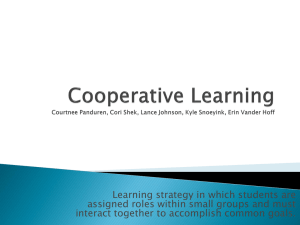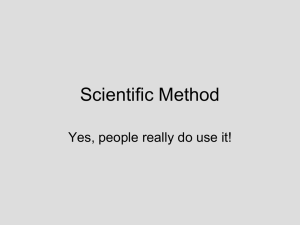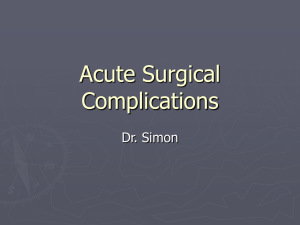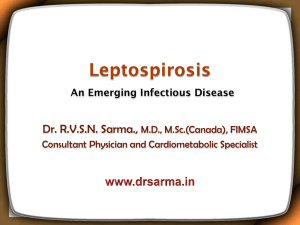file นำเสนอ - สำนักโรคติดต่ออุบัติใหม่
advertisement
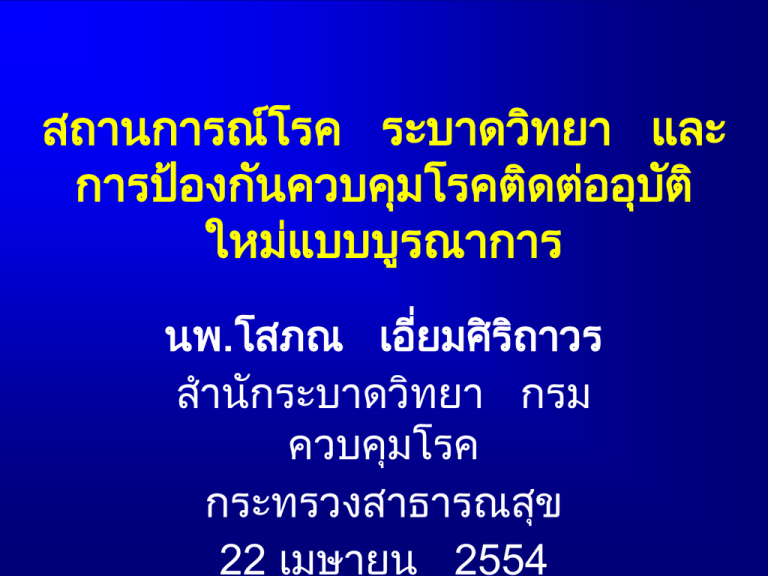
ระบาดวิทยา และ สถานการณโรค ์ การป้องกันควบคุมโรคติดตออุ ั ิ ่ บต ใหมแบบบู รณาการ ่ นพ.โสภณ เอีย ่ มศิ รถ ิ าวร สานักระบาดวิทยา กรม ควบคุมโรค กระทรวงสาธารณสุข 22 เมษายน 2554 โรคติดเชือ ้ อุบต ั ใิ หม่ (Emerging infectious diseases) นิยามองคการอนามั ยโลก หมายถึง ์ โรคติดตอเชื อ ้ ชนิดใหม่ ๆ ทีม ่ ี ่ รายงานผู้ป่วยเพิม ่ ขึน ้ ในระยะ 20 ปี ทีผ ่ านมา ่ 1) โรคติดตอที ้ ใหม่ (New ่ เ่ กิดจากเชือ infectious diseases) เช่นโรคซารส ์ ไขหวั นธุใหม ้ ดนก ไขหวั ้ ดใหญสายพั ่ ่ ์ H1N1 2009 ไขสมองอั กเสบนิปาห ์ ้ โรคติดเชือ ้ อุบต ั ใิ หม่ (Emerging infectious diseases) 3) โรคติดตออุ ั ซ ิ า้ (Re-emerging ่ บต infectious diseases) คือโรคติดตอที ่ ่ เคยระบาดในอดีตและสงบไปนาน แลวแต กลั ้ ่ บมาระบาดอีก เช่น ไข้ ชิคุนกุนยา 4) เชือ ้ โรคดือ ้ ยา (Antimicrobial resistant organism) เช่น วัณโรค ดือ ้ ยา Economic Impact of EID SARS $50bn China, Hong Kong, Singapore, Canada $30-50bn Estimated Cost $40bn $30bn Foot & Mouth UK $25–30bn $20bn $10bn BSE UK, $10-13bn Foot & Mouth Taiwan, $5-8bn Classical Swine Fever, Netherlands $2.3bn BSE Japan $1.5bn HPAI, Italy $400m Nipah, Malaysia $350-400m 1994 1995 1996 1997 1998 Figures are estimates and are presented as relative size. 1999 2000 Avian Flu Asia, $5–10bn BSE Canada $1.5bn Avian Flu, NL $500m 2001 2002 BSE U.S., $3.5bn 2003 2004 2005 2006 Global Map of EIDs Origins, 1940-2004 N=335 Source: Kate Jones, Nature 2008 Zoonotic EIDs = 60.3% (Wildlife animal origin = 71.8%) Zoonosis > 50% > 50% Source: Kate Jones Global Distribution of EIDs by Pathogens, 1940-2004 Zoonotic pathogen from wildlife Drug-resistant pathogen Source: Kate Jones, Nature 2008 Zoonotic pathogen from non-wildlife Vector-borne pathogen Pathogen risk factors All pathogens Human EIDs ไวรั ส Domestic animals ไวรั ส Domestic carnivores ไวรั ส OIE list เส้นทางการบิน ระหวางประเทศ ่ Source: PNAS, 2004 การระบาดของไข้ หวัดใหญ่ สายพันธุ์ใหม่ 2009 Number of cases 10000 9000 1st Number of deaths 100 Wave 3rd Wave 8000 90 80 Pandemic H1N1 2009 Death 7000 Influenza/ILI 6000 70 60 Pandemic H1N1 2009 Case 5000 50 2nd 4000 Wave 40 3000 30 2000 20 1000 10 0 0 2009 Week of 2010 Source: Bureau of Epidemiology, Ministry of Public Health, Thailand New Tourist Place and Emergence of Leptospirosis, Satun Province, Thailand, Dec 2007 New Tourist Place and Emergence of Leptospirosis, Satun Province, Thailand, Dec 2007 5/41 (12.2%) of tourists diagnosed Leptospirosis Source: Dr.Anek Mungaomklang , FETP-Thailand Tourists, Cave and Bats Bat’s Kidneys: 26/36 (72.2%) positive Leptospira by PCR Source: Dr.Anek Mungaomklang , FETP-Thailand Frog’s Kidneys: 1/13 (7.7%) positive Leptospira by PCR Source: Dr.Anek Mungaomklang , FETP-Thailand Serological Studies in Human and Animals Species Samples(%) Serovar Test Tourists Tour Guides (River) 5/41 (12.2%) RAN MAT 21/79 (26.6%) SHE and AUS MAT Tour Guides (Cave) 3/5 (60.0%) SHE and AUS MAT Cattle 17/17 (100%) SHE and RAN MAT Dogs 21/21 (100%) SHE and AUS MAT 3/3 (100%) SHE and AUS MAT 0/2 (0%) - MAT 26/36 (72.2%) - PCR Frogs/Toads Rats Bats Soil/Water 7 samples (neg) Source: Dr.Anek Mungaomklang , FETP-Thailand Temp 26.8 0C, Humidity 1.6% Soil pH = 7-7.5 in cave Spread of pathogens (globalized travel and trade) จานวนสั ตว์ ป่านาเข้ าถูกกฎหมาย ปี 2548-2551 6,000 2548 5,000 4,000 3,000 2,000 1,000 - ที่มา: กรมปศุสัตว์ 2549 2550 2551 จานวนแพะใน 20 จังหวัด เรียงตามลาดับ ลำดับที่ ที่มา: กรมปศุสัตว์ และสานักระบาดวิทยา จังหวัด ยอดรวมทัง้ ประเทศ 1 2 3 4 5 6 7 8 9 10 11 12 13 14 15 16 กาญจนบุร ี * ประจวบคีรข ี น ั ธ์ * ยะลา สงขลา ปัตตานี สตูล ชัยนาท นราธิวาส นครศรีธรรมราช นครสวรรค ์ * ลพบุร ี นครราชสี มา นครปฐม สระบุร ี เพชรบุร ี สุพรรณบุร ี * 17 18 19 20 กรุงเทพมหานคร กระบี่ อุตรดิตถ ์ ราชบุร ี * จานวน 383,796 24,529 24,237 23,811 19,263 18,907 17,205 15,367 15,289 14,216 12,653 11,376 10,457 10,213 9,886 9,441 9,228 * 8,526 8,489 8,302 7,652 % ของประเทศ 100.00 6.39 6.32 6.20 5.02 4.93 4.48 4.00 3.98 3.70 3.30 2.96 2.72 2.66 2.58 2.46 2.40 2.22 2.21 2.16 1.99 Q Fever • Q fever is a zoonotic disease. • Caused by Coxiella burnetii • Resistant to heat, drying, and many common disinfectants • Survive for long periods in the environment • Underdiagnosed and underreported because of limited clinical suspicion and lack of availability of diagnostic laboratories http://www.cdc.gov/ncidod/dvrd/qfever Q Fever • The primary reservoirs: cattle, sheep, and goats • C. burnetii does not usually cause clinical disease in these animals • Common mode of transmission is airborne • Ingestion of contaminated milk, regurgitation and inspiration of the contaminated food are a less common. http://emergency.cdc.gov/agent/qfever/clinicians Reported Q Fever cases 2010 Place Gender Age (years) Occupation Pets Onset Symptom Status Case1 Case2 Case3 Khonkaen Male 67 Loei Male 42 Shoes seller Kalasin Male 51 Rice farmer, livestock dog 5/2010 Fever, myalgia and back pain improve 6/2010 Fever and dyspnea improve Source: IEIP Unpublished data Rice farmer, livestock dog 3/2010 Fever and dyspnea on exertion improve ปัจจัยที่มีผลต่ อการเกิดโรคระบาด ปัจจัยระยะสั้ น – – – – การเดินทางและเคลือ่ นย้ าย คน และสั ตว์ การท่ องเที่ยว ภัยธรรมชาติ การปนเปื้ อนในกระบวนการผลิตอาหาร ปัจจัยระยะยาว – การเปลีย่ นแปลงของสภาวะอากาศ เช่ น อุณหภูมิโลก – สิ่ งแวดล้อมเปลีย่ น พืน้ ทีเ่ ขตเมืองเพิม่ ขึน้ การบุกรุกทาลายป่ า และ การไล่ล่าสั ตว์ ป่า พืน้ ที่เกิดโรคไข้เลือดออก ปี พ.ศ.2551 Risk of zoonotic disease transmission from wildlife animals to humans “One Health” Concept Human Health Ecosystem Health Animal Health Cross-sectoral and multi-disciplinary collaboration “One Health” Emergency Response Team National Provincial Community FETP (MD/DVM) Advanced level SRRT (Public Health/Animal Health/Environmental Health/Laboratory) Intermediate level Public Health Volunteers/Animal Health Volunteers/Wildlife Park Rangers/Zoo Keepers “One Health” Concept Basic level “One Health” Concept A Strategic Framework for Reducing Risks of Infectious Diseases at the Animal–Human–Ecosystems Interface A comprehensive, holistic approach required to address high impact EIDs Humans-animal-ecosystems health Multi-disciplinary, multi-sectoral Long term PREVENTION Build on existing structure Not creating new institutions Asia Pacific Strategy for Emerging Diseases (APSED) • The “One Health” approach has been applied primarily in the APSED zoonoses framework through establishment of a functional coordination mechanism between human and animal health sectors to address zoonoses. Asia Pacific Strategy for Emerging Diseases (APSED) 1.ENDORSES the Asia Pacific Strategy for Emerging Diseases (2010); 2. URGES Member States: (1) to use the Asia Pacific Strategy for Emerging Diseases (2010) (APSED 2010) as a strategic framework to guide national and local capacity-building programmes for emerging diseases and public health events; (2) to use APSED (2010) as a tool when developing relevant national plans to ensure effective preparedness for emerging diseases and the development and strengthening of the core capacities required under the International Health Regulations (2005), including enhanced surveillance and response; APSED 2010 8 Focus Areas: Key Components ระบบเฝ้ าระวังเหตุการณ์ (Event-based surveillance) SRRT อาเภอ สอบสวน ศูนย์ รับแจ้ งข่ าว รพ. สต. ตรวจสอบ แหล่ งข่ าวในชุมชน เหตุการณ์ ผดิ ปกติในชุมชน One Health แจ้ งข่ าว Joint Investigation of H5N1 Outbreak “One Health” Multidisciplinary responses to AI (H5N1) epidemic Hospital Active case finding Animal study One Health Wild bird surveillance Laboratory Pathological Examination National Committee on AI Response & Pandemic Influenza Preparedness Promote collaboration between animal and human health sector 1st National Strategic Plan on Avian Influenza and Influenza Pandemic Preparedness (2005-2007) 2nd National Strategic Plan on Avian Influenza and Influenza Pandemic Preparedness (2008-2010) มติสมัชชาสุขภาพ แห่งชาติ ครัง้ ที่ 2 โรคติดตออุ ั ใิ หม่ ่ บต 37 แผนยุทธศาสตร์ เพือ่ การบริหารจัดการโรคติดต่ ออุบตั ิใหม่ แบบบูรณาการ ประกอบด้วยเนื้อหำที่ครอบคลุมยุทธศำตร์ต่ำงๆ ได้แก่ • กำรพัฒนำกลไกควำมร่ วมมือระหว่ำงหน่วยงำนต่ำงๆที่เกี่ยวข้องรวมทั้ง ภำคประชำชน • กำรเตรี ยมควำมพร้อมในด้ำนงบประมำณ เวชภัณฑ์ ครุ ภณ ั ฑ์ และวัสดุ อุปกรณ์ เฝ้ ำระวังป้ องกันและควบคุมโรค ในสัตว์และในคน ใน ระดับประเทศ จังหวัดและท้องถิ่น • กำรสื่ อสำรสำธำรณะต้องเสนอข้อเท็จจริ ง ไม่ปิดบังและให้ควำมเข้ำใจ อย่ำงถูกต้องทั้งระดับชำติและชุมชน ในกำรรองรับโรคติดต่ออุบตั ิใหม่ • กำรสร้ำงจิตสำนึกในกำรป้ องกันโรคติดต่ออุบตั ิใหม่ 38 แผนยุทธศาสตร์ เพือ่ การบริหารจัดการโรคติดต่ ออุบตั ิใหม่ แบบบูรณาการ (ต่ อ) • กำรพัฒนำระบบบริ กำรสำธำรณสุ ขเพื่อรองรับวิกฤตที่เกิดกำรระบำด ใหญ่ของโรคติดต่ออุบตั ิใหม่ • กำรวิจยั กำรจัดกำรควำมรู ้ กำรจัดทำฐำนข้อมูล และประสำนกำรเข้ำถึง หน่วยงำนที่เกี่ยวข้องระดับวิชำกำรและปฏิบตั ิกำร • กำรค้นหำและกำรตรวจพบ เพื่อกำรรับมือกับอำวุธชีวภำพ • กำรทบทวนปรับปรุ งและบังคับใช้กฎหมำย • กำรจัดกำรสัตว์เลี้ยง สัตว์ป่ำ และกำรควบคุมสัตว์จรจัด เช่น สุ นขั แมว • พัฒนำกำรจัดกำรด้ำนสุ ขำภิบำล กำรเฝ้ ำระวังและควบคุมโรคให้มี ประสิ ทธิภำพ 39 สรุป • ปัญหาโรคติดตออุ ั ใิ หมมี ่ บต ่ แนวโน้มเพิม ่ ขึน ้ และ เกิดผลกระทบตอความ ่ มัน ่ คงดานสุ ขภาพ ้ • “One Health” สามารถ ประยุกตใช ์ ้ในการรับมือกับ กิตติกรรมประกา ศ • กรมวิทยาศาสตรการแ พทย ์ • กรมปศุสัตว ์ •องคการสวนสั ต ว ์ ์ • IEIP-TUC •WHO/FAO/OIE ์ Sawasdee



